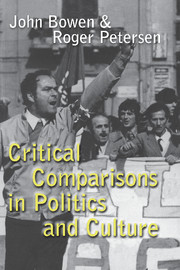Book contents
- Frontmatter
- Contents
- List of Figures
- List of contributors
- Acknowledgments
- 1 Introduction: critical comparisons
- 2 National revivals and violence
- 3 Mechanisms and structures in comparisons
- 4 Comparative methodologies in the analysis of anthropological data
- 5 The role of comparison in the light of the theory of culture
- 6 Case studies of contemporary job loss
- 7 Defining the contours of an Islamic reform movement: an essay in successive contrasts
- 8 Producing an analytic narrative
- 9 Political consciousness on Boa Ventura: 1967 and 1989 compared
- 10 Comparisons in the context of a game theoretic argument
- 11 The role of microhistories in comparative studies
- List of references
- Index of authors
- Subject index
7 - Defining the contours of an Islamic reform movement: an essay in successive contrasts
Published online by Cambridge University Press: 28 January 2010
- Frontmatter
- Contents
- List of Figures
- List of contributors
- Acknowledgments
- 1 Introduction: critical comparisons
- 2 National revivals and violence
- 3 Mechanisms and structures in comparisons
- 4 Comparative methodologies in the analysis of anthropological data
- 5 The role of comparison in the light of the theory of culture
- 6 Case studies of contemporary job loss
- 7 Defining the contours of an Islamic reform movement: an essay in successive contrasts
- 8 Producing an analytic narrative
- 9 Political consciousness on Boa Ventura: 1967 and 1989 compared
- 10 Comparisons in the context of a game theoretic argument
- 11 The role of microhistories in comparative studies
- List of references
- Index of authors
- Subject index
Summary
Anthropologists' stock in trade is the fine-grained knowledge of the local: how things happened in a particular place and time, how people thought and felt about those events. But increasingly central to the discipline are phenomena of world scale: ideologies of development, broadly diffused television programs, international religious movements. Many anthropologists now focus on how people reshape these (and other) international phenomena in their own social lives, and argue that what appears to be the homogenization of world culture is better seen as many processes of appropriation and reinterpretation.
The broad scope of these social processes poses new challenges to anthropological methods. For the comparative study of Islamic religious forms and movements, for example, what is the appropriate strategy? Older methods of regional comparison, long established in the discipline (see Johnson 1991 for a survey), focus attention on regional social and cultural traits and away from the religion's cross-regional reach; usually Middle Eastern social institutions are compared (see, for example, Keddie 1972). A two-way contrast between widely differing cultures, such as that of Morocco and Java explored in Clifford Geertz's Islam Observed (1968), highlights broad cultural contrasts but downplays the processes by which ideas and institutions are differentially transmitted and shaped (see also Lindholm 1992).
It may be that the gap between the international scope of these topics on the one hand, and the cultural detail of specific, local social forms on the other, is too wide to be bridged with a single set of comparisons.
- Type
- Chapter
- Information
- Critical Comparisons in Politics and Culture , pp. 136 - 151Publisher: Cambridge University PressPrint publication year: 1999
- 3
- Cited by



